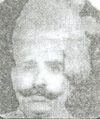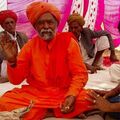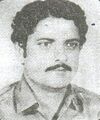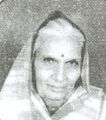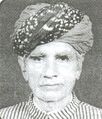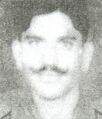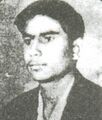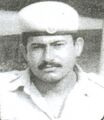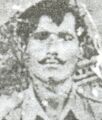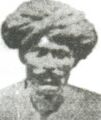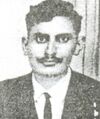Barmer
| Author:Laxman Burdak, IFS (R) |
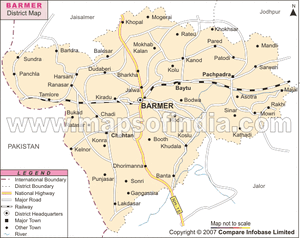

Barmer (बाड़मेर) is a city and district in the Marwar region of Rajasthan, India. Barmer is famous for sand dunes of Thar desert, its carved wooden furniture and hand block printing industry, woolen industries, gaur industries, oil. According to Alexander Cunningham[1] Barmer was the capital of ancient Gurjjara Kingdom.[2]
Variants of name
- Bāhadamer (बाहड़मेर)
- Bahadamer Kot (बाहड़मेर कोट) [3]
- Bahadameru (बाहड़मेरु) - Its ancient name was Bahadameru (बाहड़मेरु)[4].
- Balmer (by Xuanzang)
- Vagbhatameru (वाग्भटमेरू)
- Pi-lo-mi-lo or Balmer (by Xuanzang)
Origin of name
- Bahadadev Punia (born: 1097 AD ) founded Barmer in 1127 AD. He constructed Shiva temple at Jeenmata in 1178 AD. and founded Punia Kingdom at Jhansal in 1188 AD. [5]
- According to Imperial Gazetteer of India, The name Barmer is derived from the ruler Bahada Rao or Bar Rao. Imperial Gazetteer of India tells us that that the present town is said to have been founded in the 13th century, by Rājā Bāhada and to have been called after him Bāhadamer meaning “The Hill Fort of Bahada”. It is substantially built on the side of a rocky hill, on the summit of which are remains of an old fort. [6]
History
The name Barmer is derived from the ruler Bahada Rao or Bar Rao. Imperial Gazetteer of India tells us that that the present town is said to have been founded in the 13th century, by Rājā Bāhada and to have been called after him Bāhadamer meaning “The Hill Fort of Bahada”. It is substantially built on the side of a rocky hill, on the summit of which are remains of an old fort. [7]
The genealogical table of Punia clan is provided by Pandit Amichandra Sharma [8] who writes that the ancestor of Punias was Bahada who occupied a large tract of Bikaner and founded Bahadamer Kot (Barmer). Later he moved to Jhansal. 12 sons of Bahad gave name to 12 Jat Gotras:1 Punia, 2 Dhania, 3 Chhachharka, 4 Bali, 5 Barbara, 6 Sulakhan, 7 Chidiya, 8 Chandia, 9 Khokh, 10 Dhanaj, 11 Letar, 12 Kakarka The most numerous were Punias.
H.A. Rose[9] writes that Bahada or Barh's descendants are chiefly sprung from Punia and they held the country round Jhansal.
According to Alexander Cunningham[10] the capital of ancient Gurjjara country mentioned by Xuanzang was named Pi-lo-mi-lo or Balmer or Barmer.
James Todd [11] writes that Barmer, the ancient name of which is said to be Bahadamer, ' hill fort of Bahada'. Mallinath was son of Rao Salkha, eighth in descent from Siahji, founder of Marwar State.
Kiradu is a site of Shiva temple in tahsil Ramsar in District Barmer in Rajasthan. The Kiradu group of temples is situated near the village Hathma about 43 km away from the Barmer region in Rajasthan. The inscriptions dating back to 1161 AD reveal that the ancient name of this place was Kiratakupa and was once the capital of the Panwars. The temples were built around c. 1000 AD and later.
Kiradu Inscription of 1178 AD in the Shiva temple of the period of Maharaja Madanabrahmadeva Chauhan (Shakambhari reveals that the area was ruled by Tejapala and the wife of Tejapla reestablished a new statue when she found that the temple was destroyed by the turuks. [12]
There are number of festivals held in Barmer, the most famous of which is a cattle fair held every year at Tilwara village situated on the banks of the Luni river. The fair goes on for a fortnight in the months of March and April. The other major festival is the Barmer Thar Festival, started as a practice to enhance the tourism potential of this town. During the annual Barmer festival in March, the town is at its colourful best and that is the best time to visit Barmer. Siwana fort is a very old fort. it is at about 1000 years old.In local language it's name 'Gadh Siwana'.
इतिहास
चौधरी कन्हैयालाल पूनिया[13] ने लिखा है कि... लगभग 900 साल पहले श्री उतगर के दो संतान पैदा हुई जिसमें से एक का नाम बाढ़ तथा दूसरे का नाम मेर था। बाढ़देव का जन्म विक्रम संवत 1154 (1097=ई.) कार्तिक सुदी पूर्णिमा को पुणे महाराष्ट्र में हुआ। बाढ़देव ने विक्रम संवत 1184 (1127=ई.) आषाढ़ सुदी नवमी वार शनिवार को बाड़मेर की स्थापना की। बाढ़ और मेर दोनों भाईयों के नाम पर आज के बाढ़मेर का नामकरण हुआ। कालांतर में दोनों भाईयों के झगड़े का फायदा उठाकर सोढ़ा राजपूतों ने उस पर कब्जा कर लिया। बाढ़देव उत्तर भारत की ओर प्रस्थान कर गए। उनकी संताने पूनिया कहलाई और मेर महाराष्ट्र में मेरठा (मराठा) के नाम से जाने गए।
बाढ़देव बाड़मेर से विक्रम संवत 1235 (1178=ई.) में पुष्कर आए और आगे जीनमाता के स्थान पर हर्ष के पहाड़ पर शिव मंदिर बनवाया। जीनमाता ने बाढ़देव को वरदान स्वरूप एक पत्थर शीला दी और कहा कि यह जहां गिरे वहीं पर नीम की हरी शाखा काटकर डालना वह संजीवनी हो जाएगी तथा वहीं आपका राज्य सदा-सदा के लिए कायम रहेगा। पूनिया गोत्र आज भी उस शीला का आदर करता है। उस पर स्नान नहीं करते।
विक्रम संवत 1245 (1188=ई.) मिति चैत्र सुदी 2 वार शनिवार को पूनिया गोत्र के आदि पुरुष बाढ़देव ने झांसल में अपने प्रसिद्ध गणराजय की नींव रखी। विक्रम संवत 1245 से 1822 के राठोडों के साथ राजीनामे तक पुनिया आज के हिसार-पिलानी-चुरू-तारानगर एवं भादरा तक काबिज रहे। इस बीच राज्य कायम रखने के समकालीन संघर्षों में पुनियों की राजधानी झांसल से लूदी में तब्दील करनी पड़ी। पडोस के दईया सरदार दीर्घपाल पर विजय, रठौड़ों और गोदारों की संयुक्त सेना के साथ लगातार संघर्ष , जबरिया राठौड़ शासक रायसिंह द्वारा धर्मभाई बनाने का बुलावा देकर धोके से पूनिया सरदारों चेचू और खेता को अपने राजगढ़ वाले किले की नींव में दबाने का बदला राठौड़ रायसिंह के वध से लेने आदि की ऐतिहासिक घटनाएँ हुई। इस कालावधि में कान्हादेव पुनिया गोत्र का इतिहास प्रसिद्ध योद्धा बनकर उभरा जिसने लूदी में अपना स्वतंत्र गढ़ निर्माण किया। लगभग 360 गांवों का यह पूनिया गणराज्य अंतत: जोधपुर शासन के विस्तार हेतु कांधल और बीका तथा जाट गणराज्यों की फूट का शिकार हो गया।
पूनिया गोत्र की वंशावली
63. राजा अतगर उर्फ़ उतंगर (विक्रम संवत 1172 (=1115 ई.) में राज्यारोहण) - उतगर की रानी सोमवती से 4 पुत्र हुए- 1. बाढ़देव 2. मेर 3. झगड़ 4. जगदेव →
64. बाढ़देव - राजा बाढ़ कर्ण उर्फ़ कर्क की 15वीं पीढ़ी है. बाढ़देव का जन्म विक्रम संवत 1154 = 1097 ई. कार्तिक सुदी पूर्णिमा को शिवनगर शिव कोटडा, गुजरात में हुआ. दूसरे मत के अनुसार इनका जन्म विक्रम संवत 1154 = 1097 ई. कार्तिक सुदी पूर्णिमा को पुणे महाराष्ट्र में हुआ. बाढ, मेर, झगड़ और जगदेव शिवनगर शिव कोटडा, गुजरात से चलकर बाड़मेर पहुंचे. बाढ़देव ने विक्रम संवत 1184 (1127 ई.) में आसाढ़ सुदी 9 को बाड़मेर की स्थापना की और राजगद्दी पर बैठा, बाढ़देव ने बाड़मेर में 22 कुए 52 बुर्ज तथा 5 मंदिर बनवाए जिनमें शिव-मंदिर, कृष्ण-मंदिर, आददेवी-मंदिर, हनुमान-मंदिर, शनि-मंदिर सम्मिलित हैं.
बाढ़ के 12 पुत्र हुए- 1. पूनम (जन्म: विक्रमी संवत 1235 = 1178 ई.) 2. गोखर 3. धान्धरिक अथवा छाछरेक 4. सुलखन 5. मनमोड या मनमोड़ा 6. अडवाल 7. इहिर 8. खोख अथवा खोखकर 9. लेंतर 10. काकरेल उर्फ़ काकरिक 11. गोलू उर्फ़ गोयल 12. बोखर उर्फ़ बीखर
बाढ़ के 3 पुत्री हुई - 1. धानिया 2. चिड़िया 3. चांदिया
बाढ़ ने विक्रमी संवत 1184 (1127 ई.) में बाड़मेर बसाया तथा विक्रमी संवत 1230 (1173 ई.) में बाड़मेर छोड़ा. फिर बाढ़देव ने विक्रमी संवत 1245 (1188 ई.) में झांसल की स्थापना की.
दोहा - बाढ़ सरिखा चौधरी झांसल बरगा कोट, सात पट्टी सत्ताईस माझरा बसें बाढ़ की ओट.
बाढ़ के पुत्र पूनम विक्रमी संवत 1235 (1178 ई.) में पैदा हुए जो बाढ़ के बाद राजा बने .
Mention by Alexander Cunningham
Alexander Cunningham[14]writes that Hwen Thsang places the second kingdom of Western India, named Kiu-che-lo or Gurjjara, at about 1800 li, or 300 miles, to the north of Balabhi, and 2800 li, or 467 miles, to the north-west of Ujain. The capital was named Pi-lo-mi-lo or Balmer[15], which is exactly 300 miles to the north of the ruins of Balabhi. From Ujain in a straight line it is not more than 350 miles ; but the actual road distance is between 400 and 500 miles, as the traveller has to turn the Aravali mountains, either by Ajmer on the north, or by Analwara on the south. The kingdom was 5000 li, or 833 miles, in circuit. It must, therefore, have comprised the greater part of the present chiefships of Bikaner, Jesalmer, and Jodhpur. Its boundaries can only be described approximately, as extending about 130 miles on the north from Balar or Sirdarkot to Junjhnu ; 250 miles on the east from Junjhnu to near Mount Abu ; 170 miles on the south from Abu to near Umarkot ; and 310 miles on the west from Umarkot to Balar. These figures give a total circuit of 860 miles, which is as close an approximation to the measurement of Hwen Thsang as can be reasonably expected.
All the early Arab geographers speak of a kingdom named Jurz or Juzr, which from its position would appear to be the same as the Kiu-che-lo of Hwen Thsang. The name of the country is somewhat doubtful, as the unpointed Arabic characters may be read as Haraz or Hazar, and Kharaz or Khazar as well as Jurz or Juzr. But fortunately there is no uncertainty about its position, which is determined to be Rajputana by several concurring circumstances.
[p.313]: Thus the merchant Suliman, in A.D. 851,[16] states that Haraz was bounded on one side by Tafek or Takin, which, as I have already shown, was the old name of the Panjab. It possessed silver mines, and could muster a larger force of cavalry than any other kingdom of India. All these details point unmistakably to Rajputana, which lies to the south-east of the Panjab, possesses the only silver mines known in India, and has always been famous for its large bodies of cavalry.
According to Ibn Khordadbeh,[17] who died about A.D. 912, the Tatariya dirhems were current in the country of Hazar ; and according to Ibn Haukal, who wrote about A.D. 977,[18] these dirhems were also current in the kingdom of Gandhara, which at that time included the Panjab. Suliman says the same thing of the kingdom of the Balhara, or the present Gujarat ; and we learn incidentally that the same dirhems were also current in Sindh, as in a.h. 107, or A.D. 725, the public treasury contained no less than eighteen millions of Tatariya dirhems.[19] The value of these coins is variously stated at from 1-1/8 dirhem to 1½ or from 54 to 72 grains in weight. From these data I conclude that the Titariya dirhems are the rude silver pieces generally known as Indo-Sassanian, because they combine Indian letters with Sassanian types. They would appear to have been first introduced by the Scythic or Tatar princes, who ruled in Kabul and north-western India, as they are now found throughout the Kabul valley and Panjab, as well as in Sindh,
[p.314]: Rajputana, and Gujarat. Colonel Stacy's specimens were chiefly obtained from the last two countries, while my own specimens have been procured in all of them. In weight they vary from 50 to 68 grains ; and in age they range from the fifth or sixth century down to the period of Mahmud of Ghazni. They are frequently found in company with the silver pieces of the Brahman kings of Kabul, which agrees with the statement of Masudi that the Tatariya dirhems were current along with other pieces which were stamped at Gandhara.[20] The latter I take to be the silver coins of the Brahman kings of Kabul, whose dynasty began to reign about A.D. 850, or shortly before the time of Masudi, who flourished from A.D. 915 to 956. I have also found some of the Indo-Sassanian or Tatar dirhems in central India to the east of the Aravali range, as well as in the Upper Gangetic Doab ; but in these provinces they are extremely scarce, as the common coin of Northern India in the mediaeval period was the Vardha, with the figure of the Boar incarnation of Vishnu, varying from 55 to 65 grains in weight. From this examination of the coins I conclude that the kingdom named Hazar or Juzr by the early Arab geographers, is represented as nearly as possible by Western Rajputana.
Edrisi,[21] quoting Ibn Khordadbeh, states that Juzr or Huzr was the hereditary title of the king, as well as the name of the country. This statement confirms my identification of Juzr with Guzr or Gujar, which is a very numerous tribe, whose name is attached to
[p.315]: many important places in north-west India and the Panjab, and more especially to the great peninsula of Gujarat. It is not known when this name was first applied to the peninsula. In early times it was called Saurashtra, which is the Surastrene of Ptolemy ; and it continued to bear this name as late as A.D. 812, as we learn from a copper-plate inscription found at Baroda.[22] In this record of the Saurashtra kings, Gurjjara is twice mentioned as an independent kingdom.
About A.D. 770 the king of Grurjjara was conquered by Indra Raja of Saurashtra, but was after-wards reinstated; and about A.D. 800 Indra's son Karka assisted the ruler of Malwa against the king of Gurjjara. These statements show most clearly that Gurjjara still existed as a powerful kingdom, quite distinct from Saurashtra, nearly two centuries after Hwen Thsang's visit in A.D. 640. They show also that Gurjjara must have been adjacent to Malwa, as well as to Saurashtra, a position which clearly identifies it with Rajputana, as I have already determined from Hwen Thsang's narrative.
Juna Adinath Temple
To the immediate west of the city lie the remains of Juna or Juna Barmer and to the south are the ruins of three Jain temples. There is an inscription dated 1295 AD on one of the pillars of the hall of the largest temple at Juna. This mentions Maharajakula Sri Samanta Sinha Deva ruling Barmer at the time. This Inscription reveals that Barmer was an important trade cantre at that time. There used to pass from this area caravans of camels, horses, oxen etc. carrying trade items . The Mahajanas had accepted tax (lāga) for temple management. This Inscription uses terms like sārtha, pāilā, bhīmapriya, vishopaka, lāga etc. Here is the text of the Inscription:
XXII Juna Barmer Stone Inscription of V.S. 1352 (1295 AD)
|
| Juna Barmer Stone Inscription of 1295 AD [23] |
This inscription was found at Juna or Juna Badmer, as the full name goes, in the Malani District, Jodhpur State, aboat 12 miles south-west of Badmer, the principal town. It is engraved on a pillar in the porch of a dilapidated Jaina temple and contains 10 lines of writing. The characters are Nagari, The language is Sanskrit, and the whole of the inscription is in prose, excepting the benedictory verse at the end. In respect of orthography, the only points that call for notice are (1) the employment of the sign of v for both v and b, and (2) the use of the number 2 after Sri in L.3 to mark the repetition. As regards rare or unusual words, those that deserve to be noted are paila and vimsopaka in L.7, Paila and Bhimapriya vimsopiika have been already explained. Bhimapriya appears to have been the name of a kind of vomsopaka coin. Attention may also be drawn to the word Laga in L.8, which means a cess, as previously explained (No. XI above.)
The record opens with the date, the 4th of the bright half of Vaisskha in the [Vikrama] year 1352. On the aforesaid day, daring the victorious reign of the Maharajakula, Sri-Samantasimhadeva, the mahamta Chirasila, Velaula, the Bhamdari Migala, and others appointed by the king to draw up documents, made a religions grant at Bahadameru to the gods Vighnamardana-Kshetrapala and Chaumdaraja, in the temple of Adinatha. The grant consisted of a paila from every incoming or outgoing caravan exceeding ten camels and twenty bullocks. In default of this payment in kind, ten Bhimapriya vimsopakas were to be charged. The grant wag to be distributed equally between the two gods. In L.8 is recorded the approval of this cess (laga) by the mahajanas or local bankers. Bahadameru is, of course, Badmer, not the place now known by that name which is comparatively a modern city, but Juna Badmer, the old Badmer where the inscription was found.
Notes by Wiki editor
- Bahadameru (बाहड़मेरौ) = Barmer Rajasthan
Tahsils in Barmer
Barmer, Baytoo, Chohtan, Dhorimanna, Gadraroad, Gira, Gudha Malani, Pachpadra, Ramsar, Samdari, Sheo, Serva, Sindhari, Siwana,
Villages in Barmer tahsil
Abhaniyon Ka Sara, Adarsh Basti Bishala, Adarsh Basti Nand, Adarsh Chawa, Adarsh Undkha, Akal, Alaniyon Ki Dhani, Alika Tala, Andaniyon Ka Tala, Andeka Tala, Asara Ki Beri, Asuon Ki Dhani, Ati, Bakaniyon Ka Was, Bakhse Ka Tala, Balau, Balera, Bandra, Bankana, Bankasar, Barmer (M), Barmer (Rural), Barmer Adrash Agoor, Barmer Agor, Barmer Gadan, Barmer Magra, Beebara, Berdho Ki Dhani, Beriwala Gaon, Beriwala Tala, Bhadarwa, Bhadarwa Purohitan, Bhadres Gandhau, Bhadres Punasiya, Bhation Ka Der, Bhurtiya, Bidasar, Bola Barmer, Boliya Jageer, Bothiya Purohitan, Chak Dholka, Chaklani, Chandoniyon Ki Dhani, Chawa, Chhapari, Chokhoniyon Ki Dhani, Chooli, Dablisara, Danta, Daroora, Daukiyon Ki Dhani, Daulaniyonka Tala, Dewaniyon Ki Dhani, Dhandhu Pura, Dhiraniyon Ki Dhani, Dholaniyon Ki Dhani, Dhoondha, Doodaberi, Doongeron Ka Tala, Dudiyo Ki Dhani, East Matasar, Galaberi, Gangasara, Garal, Garal Sujan Singh, Gehoon, Ghane Ka Tala, Gorasiyon Ka Tala, Gule Ka Nadiya, Gurisar, Hajhaniyon Ki Dhani, Hanuman Sagar, Hapon Ki Dhani, Hariyali, Harsana, Harupechiyon Ki Dhani, Hathitala, Hathitala Station, Indra Colony, Ishwer Pura, Jaduon Ki Nadi, Jaitaniyon Ki Dhani, Jakhdon Ki Dhani, Jalipa, Jalipa Agor, Janiyawas, Jasai, Jasontaniyon Ki Dhani, Jatiya Kumaharon Ki Basti, Jharwa, Jogesar Kua, Joona Patrasar, Juneja Mehron Ki Basti, Kadwasron Ki Dhani, Kagau, Kamoipura, Kanora, Kapoordi, Kerawa, Kerli, Kharinga Kua, Khariya Tala, Kharthasar Nadi, Khudasa, Kudla, Kumharon Ka Tala, Kurja, Lakhetali, Lalaniyon Ki Dhani, Langera, Lani Kantha, Legon Ki Dhani, Lolti Hight Bara, Lookhon Ka Tala, Loonoo Khurd, Lopali Nadi, Lunu Agor, Lunu Kalan, Madpura Sani, Magnaniyon Ki Dhani, Magne Ki Dhani, Mahabar, Malwa, Mando Ka Tala, Maroodi, Matasar, Maylon Ka Der, Meethari Khurd, Meethra, Megwalon Ka Tala, Megwalon Ki Dhani, Mhabar Peethal, Mithisar, Moodhnon Ki Dhani, Moodhon Ka Tala, Moodhonki Dhani, Motiyoniyon Ka Tala, Naguesiyan Dhoondha, Nand, Nangana, Naraniyon Ki Dhani, Nathaniyon Ka Was, Naukh, Navji Ka Pana, Naya Bhurtiya, Nimbasar Nadi, Panchaniyon Ki Dhani, Para, Phoosaniyon Ka Tala, Pindiyon Ka Tala, Pokar Bhadu Ki Dhani, Pooniyon Ki Basti, Poulaniyon Ki Dhani, Pragniyon Ki Dhani, Prajawaton Ki Dhani, Pumdro Ki Basti, Purohition Ki Basti, Radwa, Raiko Ki Dhani, Ramderiya, Rampura Garal, Ramsar Ka Kua, Rani Gaon, Ranigaon Kalan, Rauji Ki Dhani, Rawatsar, Ridmlaniyon Ki Dhani, Rohili, Sadulaniyon Ka Tala, Samon Ki Dhani, Sanawara, Sangana Kua, Sanjata, Sansiyon Ka Tala, Sansiyon Ki Basti, Sar Ka Par, Sarli, Sarli Kalan, Sarnon Ka Tala, Sarnoo Bhimji, Sarnoo Chimanji, Sarnoo Panji, Satal Bhakhri, Sauonki Dhani, Segari, Sejuon Ki Dhani, Sesau, Shiv Bhakhri, Shivkar, Sidhaniyon Ki Dhani, Sindhiyon Ki Dhani, Siyagon Ki Dhani, Sokhru, Somaniyon Ki Dhani, Sonari, South Matasar, Sura Charnan, Sura Jageer, Sura Narpatan, Sutharon Ka Tala, Sutharon Ki Dhani, Sutharonka Kua, Tirsingra, Tirsingri, Undkha, Utarlai, Vishala, Vishala Agor,
Jat Gotras in Barmer district
Barmer is the western part of Marwar region and is important Jat belt. We do not have any combined report which can give details about the distribution of Jat gotras in Marwar region. Jatlandland has compiled information which can bee seen here -
See Complete list of Jat Gotras in Barmer District
Migration of Jats to Barmer district

Dr S.Jabir Raza writes that Jats and Meds have been the oldest occupants of Sind. The first Persian account of the 11th century Mujmat ut-Tawarikh (1026), originally an ancient work in Sanskrit, mentions Jats and Meds as the ancient tribe of Sind and calls them the descendants of Ham, the son of Noah. [24] [25]
Dr S.Jabir Raza further writes that as for the migration of Jats from Sind, it may be assumed that natural calamity and increase in population compelled them to migrate from their original abode in search of livelihood.[26]Hoernle has propounded the 'wedge theory' for the migration of most of the ancient tribes. This wedge theory tends us to believe that the Jats were among the first wave of the Aryans, and their first southeast migration took place from the Nort-West, and established their rule at Sorpur in Multan regions. Further they migrated towards east and stretched their abode from Brahmanabad (Mansura) to Kathiawar. As Jataki, the peculiar dialect of the Jats, also proves that the Jats must have come from the NW Punjab and from other districts (e.g. Multan) dependent upon the great country of the Five rivers.[27] By the end of fifth and the beginning of the sixth century, their southward migration, second in line, took place and they reached Kota in Rajasthan, probably via Bikaner regions. From Kota they migrated further east and established their rule at Malwa under the rule of Salichandra, son of Vira Chandra. Salichandra erected a minster (mindra) on banks of the river Taveli in Malwa.[28] Probably after their defeat by Sultan Mahmud in 1027 AD, and later hard pressed by the Ghaznavi Turkish Commander, the Jats of Sind again migrated to Rajasthan and settled themselves in Bundi regions.The second inscription found at Bundi probably dates from circa samvat 1191 (1135 AD) possibly refers to the Jats as opponents of the Parmara rulers of Rajasthan. [29][30]
When Muhammad bin Qasim attacked Dahlilah, a fortified town in between Roar and Brahmanabad, most of the inhabitants (the Jats) had abandoned the place and migrated to Rajasthan via desert and took shelter in the country of Siru (modern Sirohi) which was then ruled by King Deva Raj, a cousin of Rai Dahir.[31] However, the third migration took place in early eighth century and Jats of lower Sind migrated to Rajasthan, probably via Barmer regions. By the twelfth century, the Jats settled in western Punjab, as the native poet Abul Farj Runi mentions them along with the Afghans.[32]Meanwhile, they also extended their abode in the eastern part of the Punjab (now Haryana), as in the end of the twelfth century they resisted Qutb-ud-din Aybak in the region of Hansi. [33][34]
Role of Barmer in movement for reservation in jobs
Notable persons from Barmer district
Political leaders
- Hema Ram Chaudhary - Baytu Bhimji (Barmer)
- Chaudhary Aaidanji Bhadu - चौधरी आईदानजी भादू - बाड़मेर
- Ganga Ram Chaudhary
- Harish Choudhary
- Madan Kaur
- Taga Ram Chaudhary
- Col. Sona Ram Chaudhary
- Kailash Choudhary Moond Moondh
Social workers
- Mangi Lal Dhaka - Hudo Ki Dhani(Barmer)
- Harchand Ram Moond - Bataru (Barmer)
- Ramdan Dookiya - Kharin (खड़ीन) (Barmer)
- Amara Ram Saran - Sawau
- Bana Ram Jakhar - Kau Ka Khera (Chhitar Ka Par)
- Purakha Ram Chaudhary - Lapundara
- Jodha Ram Saran - Rawatsar
- Harlal Siyag - Chadi
- Jetha Ram Beniwal - Garal
- Sonaram K Jat (Thori) - Bhurtiya
- Joga Ram Saran - Journalist Barmer. Author of book 'Barmer Ke Jat Gaurav' Released on 12 July 2009.
- Poonam Kumar Chaudhary - Player
- Heera Ram Dhaka, Hudo Ki Dhani
- Rekha Ram Sou - Maruti Group, Social worker from village Baldeo Nagar, Barmer, Rajasthan. He donated Rs. 110000 for construction of one room for Jat Dharmshala Haridwar.
- केशरी मल डूकिया, बाड़मेर- मारवाड़ जाट कृषक सुधार सभा की प्रबंधकारिणी और कार्यकारिणी में रहकर आप ने जाट जाति की सेवा करके अपने को कृतार्थ किया है। [35]
- भीकम चंद, बाड़मेर- मारवाड़ जाट कृषक सुधार सभा की प्रबंधकारिणी और कार्यकारिणी में रहकर आप ने जाट जाति की सेवा करके अपने को कृतार्थ किया है। [36]
The saints
- Khema Baba - Vayatu (Barmer)
- Jagdish Puri - Chohtan
- Mot Nath - Lilsar
- Jagram Puri - Taratara
- Manak Chand Yati - Netrad
- Jeth Nath Paramhans - Kolu
- Nrisinh Das - Bisarniya
- Utsah Ramji - Booth
- Sant Harji Ram - Taku Beri
Gallantry Award winners
- Chetan Ram Saran - Ashoka Chakra Award 1965 Indo-Pak War
- Rupchand Chaudhary (Tarad) - Shaurya Chakra Award 1971 Indo-Pak War
- Dharma Ram Beniwal - Shaurya Chakra Award 2016 (मरणोपरांत)
The Martyrs
- Bagha Ram Lukha, Kosariya
- Bala Ram Saran, Khokhsar
- Babu Lal Siyag, Bheemra
- Bhikha Ram Moondh, Patasar
- Chima Ram Godara, Chandesara
- Dewa Ram Beniwal, Lilala
- Dharma Ram Beniwal, Taratara
- Aaidan Ram Godara, Udasar
- Ganga Ram Bana, Pooniyon Ka Tala
- Hema Ram Godara, Beriwala Tala (Rawatsar),
- Hema Ram Siyag, Madpura Barwala
- Hukma Ram Godara, Madhasar
- Jeha Ram Potalia, Bayatu Chimanji
- Karana Ram Sau, Bhimra
- Khimraj Saain, Tilwara
- Kumbha Ram Siyag, Madhasar
- Lala Ram Tarad, Gagaria
- Lala Ram Saran, Jhakh
- Magha Ram Beniwal, Khattu
- Magha Ram Karwasra, Baytu Bhimji
- Magna Ram Karwasra, Sisodiyon Ka Pana
- Mangana Ram Sanee, Panawra
- Mala Ram Potalia, Bayatu Chimanji
- Moola Ram Senwar, Bisaraniya
- Mota Ram Godara, Korna
- Nand Ram Bhukar, Kharin
- Narayan Ram Karwasra, Bheemra
- Narayan Ram Kakar, Nosar
- Narayan Ram Legha, Holani
- Rawata Ram Jani, Chandesara
Victims of Jagirdars
Before India became free, in Jagir areas of Marwar state all cultivators were really landless. There was no tenancy Law and one could be thrown away from the land one cultivated at the pleasure of Jagirdar, his "malik". In most of the Jagirs a Jagirdar would in the first instance be taking fifty percent of the produce. This would be taken by actual division of the produce on the thrashing floor or by appraisal of the standing crop (kunta). The latter method proved at times more onerous as the appraisal depended on the whims of the Kamdar. Then over and above the share of the produce the farmer had to pay numerous "lags" or cesses. There were 64 kinds of begars (work without pay) prevalent in Marwar. Together with the share of the produce known as "Hasil" these cesses meant that the farmers had to part with more than eighty percent of their produce. The findings of the Sukhdeonarain Committee in the years 1940-42 bear this out. If a farmer had to marry his daughter he had to pay "Chavri Lag" if he held a dinner then a "Kansa Lag"; if members of the family separated then "Dhunwa Lag" and so on. If the Jagirdar had a guest then fodder for his mount had to be supplied. Then there was "begar" that is forced labour, for tilling the personal lands of the Jagirdar. The homestead in which the farmer lived in the Abadi had to be vacated in case he ceased cultivating the land. He could not alienate the plot to anyone. The oppression of the public by traditional Jagirdars (feudatories) of Marwar state made the life of farmers difficult, which led to a sort of class war. Jats were most affected by excesses of Jagirdars. Here is the list of Jat farmers from Barmer district who lost their life in struggle against the Jagirdars.
- Adu Ram Bana 12 October 1964, Derasar, Ramsar Tahsil
- Ana Ram Moondh in 1950, Chiriya: tah: Baytoo
- Bhauma Ram Dudi in year 1961, Chokhla, Baytu tahsil
- Bhikha Ram Daukiya, Dungar Ram Daukiya, Kundawa, Gudha Malani Tahsil
- Chima Ram Siyag in year 1950, Sawau
- Deda Ram Gorasia, Karna - tah:Gudha Malani
- Deraj Ram Karwasra in year 1950, Hironion Ka Tala (Jaisar), tah:Chohtan
- Goma Ram Saran in year 1951, Kanor, tah: Baytoo
- Harchand Siyol in year 1951, Jaisar, Akdara, tah: Baytoo
- Jag Ram Khoth in year 1950, Akdara, tah: Baytoo
- Kala Ram Godara in year 1952, Bhatala, tah: Gudha Malani
- Khiya Ram Saran in year 1952, Goliya Jetmal, tah: Gudha Malani
- Narsinga Ram Gujar in year 1955, Paushal, Sheo Tahsil
- Natha Ram, Ganga and her 4 year daughter year 1949, Bijrad - tah: Chohtan
- Pem Ram Saran in year 1960, Sanwlor, Chohtan Tahsil
- Pema Ram Paliwal in year 1952, Mehlu, tah: Gudha Malani
- Roopa Ram Karwasra in year 1950, Hironion Ka Tala (Jaisar), tah:Chohtan
- Thakara Ram Siyag, Gangasara, Chohtan tahsil
- Uda Ram Jakhar, Bakhasar, Chohtan Tahsil
Jat Officers from Barmer District
- Achala Ram Karwasra - Commandant BSF, from village Madpura Barwala (Barmer),
- Amar Singh Chaudhary Daukiya - RPS from village Kharin (Barmer), DOB:-2-1930
- Bhaira Ram Potalia - IRS (2008) from village Mithariya Tala (Barmer), DOB:2-7-1977
- Besara Ram Sau - Dy. Commandant BSF, from village - (Barmer),
- Bhanwar Lal Daukiya - RPS from village Kharin (Barmer),
- Chena Ram Saran - RAS (2000) from village Rawatsar Barmer (Barmer), DOB:9-12-1958
- Col. Sukh Ram Chaudhary Siyag - from village Madpura Barwala (Barmer), DOB:15-12-1950
- Devendra Kumar Beniwal - IES (1999) from village Garal (Barmer),
- Ganga Ram Bhambhu - 2 IC BSF, from village Madpura Barwala (Barmer), DOB:12-8-1945
- Gumana Ram Legha - RAS (2003) from village Anta Barmer (Barmer), DOB:14-2-1976
- Jagdish Godara - RPS from village Baytoo (Barmer),
- Jawahar Chaudhari (Saran) - RAS (2005) from village Rawatsar Barmer (Barmer), DOB:1-1-1974
- Jogendra Poonia - IRS from village Jalipa (Barmer), DOB:5-4-1978
- Jor Singh Sau - Commandant RAC, from village Bhuratiya (Barmer), DOB:13-1-1944
- Kisana Ram Chaudhary Godara - IES (1994) from village Baytoo (Barmer), DOB:1-9-1972
- Labhu Ram Siyag - IPS from village Taratara (Barmer), DOB:10-10-1977
- Lakshman Ram Choudhary (Karwasra) -IES(2016) From Village Hudo Ki Dhani Tehsil Baytoo (Barmer)
- Magha Ram Chaudhary (Jakhar) - RAS (2000) from village Kudla (Barmer), DOB:1-5-1958
- Mahendra Singh Chaudhary (Daukiya) - IPS from village Kharin (Barmer), DOB:1-7-1961
- Mangi Lal Saran - Commandant BSF, from village Kharin (Barmer),
- Manoj Jakhar - RPS (2000) from village Chhitar Ka Par (Barmer), DOB:1-2-1972
- Moola Ram Chaudhari Sau - RAS from village Bheemra (Barmer),
- Nathu Ram Chaudhary (Moondh) - Chief Engineer, Railways, IES 1985 from Bayatu Panji (Barmer), DOB:10-12-1960
- Nawala Ram Daukiya - RPS from village Kharin (Barmer),
- Nimba Ram Saran - RPS from village Sawau Padamsingh (Barmer),
- Om Prakash Machra (Dr): IAS 2016 Batch, Sindhari, Barmer, Rajasthan, M: 7597577977
- Panna Ram Siyag - IFS (1986) from village Janiana (Barmer), DOB:5-1-1961
- Raj Kumar Saran - RPS (1997) from village Sawau (Barmer), DOB:6-8-1966
- Virdha Ram Chaudhary Godara - Rajasthan Accounts Service (1995) , from village Hira Ki Dhani (Barmer),
- Prahlad Dudi - RAS (2012), from Barmer [37]
- Bhupendra Dudi - RAS (2012), from Barmer [38]
- Dharmendra Khadaw - RAS (2012), from Barmer [39]
- Bhanwar Lal Delu (Dr): IAS (P) 2014 batch, Rajasthan Cadre, Assist Collector, Jodhpur, from Barmer, M: +91 88 90 463322
- Labhu Ram (): IPS 2004, Karnataka Cadre, Presently posted as DCP West, Bangalore, from Barmer, M: 9448084440
Jat monuments and Jat Institutions in Barmer District
- 1. Kisan Chhatrawas, Barmer: Founded on 30 June 1934. It has Residential Rooms-26, WC-14, Common Halls-3, Office Rooms-4, Kitchen-1, Shopps-50 (For sustained Income), Associated with it is one Girls Hostel under construction.
- 2. Harlal Siyag Shodh Evam Shikshan Sansthan, Barmer: Founded in memory of Harlal Siyag who was murdered on 2 June 1995 for his struggle and for taking up community cause. It has Residential Rooms-24, Kitchen-1,
- 3. Baldev Ram Mirdha Kisan Chhatrawas, Chohtan: Founded in memory of Baldev Ram Mirdha in 1991. It has Residential Rooms-34 for accommodating 110 students, WCs, Common Hall capacity 400, Office Rooms-4, Kitchen-1,
- 4. Kisan Mahila Chhatrawas, Chohtan: Founded on 7 May 1995. It has Residential Rooms-31, WCs, Common Hall, Office Room, Kitchen-1,
- 5. Chaudhary Charan Singh Chhatrawas, Sindhari: Founded in 1997. It has Residential Rooms-24, WCs, Common Hall-1, Office Rooms-1, Kitchen-1, Shopps-11 (For sustained Income),
- 6. Ramdan Dookya Chhatrawas, Bheemra
- 7. Veer Tejaji Vikas Sansthan, Balotra: Founded on 16 June 1997. It has Residential Rooms-24, WC-s, Common Halls-2, Office Rooms-4, Kitchen-1, Shopps-44 (For sustained Income),There is a Girls Hostel in the Campus with 24 rooms.
- 8. Jat Charitable Trust, Barmer: Founded on 16 Feb. 1987. It has Residential Rooms-30, WCs, Common Hall-1, Office Rooms, Kitchen-1, Shopps-2 (For sustained Income),
- 9. Ramdan Dookya Chhatrawas, Ramsar: Registered on 15-9-1999/30
- 10. Kisan Chhatrawas, Dhoromanna:
- 11. Kisan Chhatrawas, Gudha Malani: Registered in 2004-05
- 12. Kisan Vikas Samiti Chhatrawas, Gida: Registered in 2005-06
- 13. Jat Charitable Trust Bhawan - Situated in Nehru Nagar, Barmer, Constructed with a cost of Rs. 70 Lakhs, Inaugurated on 12 July 2009 by Hema Ram Chaudhary, Revenue Minister of Rajasthan.
- 14. Kisan Boarding House (Girls) - The First Jat Girls Hostel in Barmer was inaugurated on 2 August 2009.
Gallery of martyrs from Barmer district
External Links
References
- ↑ The Ancient Geography of India/Gurjjara,p. 312
- ↑ James Todd Annals/Sketch of the Indian Desert, Vol.III, p.1269, fn-3 says The old name of Bhinmal was Srimal or Bhillamala, which Erskine (iii. A. 194) identifies with Pi-lo-mo-lo of Hiuen Tsiaug. But Beal (Buddhist Records of the Western World, ii. 270) transliterates this name as Balmer or Barmer.
- ↑ Jat Varna Mimansa (1910) by Pandit Amichandra Sharma, p.41-42
- ↑ Encyclopaedia of Jainism, Volume-1 By Indo-European Jain Research Foundation p.5505
- ↑ Kanhaiyalal Punia:Hanumangarh Jila Jat Samaj Smarika-2010,p.16-17
- ↑ Imperial Gazetteer of India, v. 7, p. 23.
- ↑ Imperial Gazetteer of India, v. 7, p. 23.
- ↑ Jat Varna Mimansa (1910) by Pandit Amichandra Sharma, p.41-42
- ↑ A glossary of the Tribes and Castes of the Punjab and North-West Frontier Province By H.A. Rose Vol II/J,p.375
- ↑ The Ancient Geography of India/Gurjjara,pp. 312-315
- ↑ James Todd Annals/Sketch of the Indian Desert,p.1272,fn-2
- ↑ डॉ गोपीनाथ शर्मा: 'राजस्थान के इतिहास के स्त्रोत', 1983, पृ. 97 -98
- ↑ Kanhaiyalal Punia:Hanumangarh Jila Jat Samaj Smarika-2010,p.16-17
- ↑ The Ancient Geography of India/Gurjjara,pp. 312-315
- ↑ James Todd Annals/Sketch of the Indian Desert, Vol.III, p.1269, fn-3 says The old name of Bhinmal was Srimal or Bhillamala, which Erskine (iii. A. 194) identifies with Pi-lo-mo-lo of Hiuen Tsiaug. But Beal (Buddhist Records of the Western World, ii. 270) transliterates this name as Balmer or Barmer.
- ↑ Dowson's Sir Henry Elliot, i. 4.
- ↑ Dowson's edition of Sir Henry Elliot's Muhamm. Hist., i. 13.
- ↑ Ibid, i. 35.
- ↑ Sir Henry Elliot, ' Arabs in Sindh,' p. 36. Dowson's edit. i. 3.
- ↑ Dowson's edition of Sir Henry Elliot's Muliamm. Hist., i. 24.
- ↑ Geogr., i. 175, Jaubert's translation.
- ↑ Journ. Asiat. Soc. Bengal, viii. 300.
- ↑ Epigraphia Indica Vol. XI (1911-12): A S I, Edited by E. Hultzsoh, Ph.D. pp.59-60
- ↑ Mujmat ut-Tawarikh, Ed. Vol.I p. 104
- ↑ Dr S.Jabir Raza, The Jats - Their Role and Contribution to the Socio-Economic Life and Polity of North and North West India. Vol I, 2004, Ed Dr Vir Singh,p. 55
- ↑ Dr S.Jabir Raza, The Jats - Their Role and Contribution to the Socio-Economic Life and Polity of North and North West India. Vol I, 2004, Ed Dr Vir Singh, pp.58-59
- ↑ Richard F. Burton, op. cit., p.246
- ↑ Inscription No.1, Tod, op.cit., Vol.II, Appendix pp. 914-917.
- ↑ Dr S.Jabir Raza, The Jats - Their Role and Contribution to the Socio-Economic Life and Polity of North and North West India. Vol I, 2004, Ed Dr Vir Singh, p.59
- ↑ Inscription No.II, Tod, op.cit., Vol.II, Appendix, pp. 917-919 and n. 13
- ↑ Chachnama, p.166
- ↑ Dr S.Jabir Raza, The Jats - Their Role and Contribution to the Socio-Economic Life and Polity of North and North West India. Vol I, 2004, Ed Dr Vir Singh
- ↑ Dr S.Jabir Raza, The Jats - Their Role and Contribution to the Socio-Economic Life and Polity of North and North West India. Vol I, 2004, Ed Dr Vir Singh, p.61
- ↑ Hasan Nizami, Tajul-ma'asir, Fascimile translation in ED, Vol. II, p.218
- ↑ Thakur Deshraj: Jat Jan Sewak, 1949, p.209
- ↑ Thakur Deshraj: Jat Jan Sewak, 1949, p.210
- ↑ Jat Gatha, September-2015,p. 15
- ↑ Jat Gatha, September-2015,p. 15
- ↑ Jat Gatha, September-2015,p. 15
Back to Marwar




